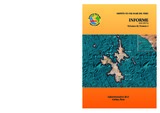Por favor, use este identificador para citar o enlazar este ítem:
https://hdl.handle.net/20.500.12958/2988Registro completo de metadatos
| Campo DC | Valor | Lengua/Idioma |
|---|---|---|
| dc.contributor.author | Delgado Loayza, Elcira | - |
| dc.contributor.author | Chang, Flor | - |
| dc.date.accessioned | 2016-03-29T16:10:43Z | - |
| dc.date.available | 2016-03-29T16:10:43Z | - |
| dc.date.issued | 2015 | - |
| dc.identifier.citation | Inf Inst Mar Perú 42(3), 2015. p. 389-397 | es_ES |
| dc.identifier.uri | https://hdl.handle.net/20.500.12958/2988 | - |
| dc.description | Informe IMARPE vol.42 n°3, 2015 p. 389-397 | es_ES |
| dc.description.abstract | Los volúmenes de plancton presentaron un rango entre 0,008 y 5,251 mL.m-3 localizados frente a Punta La Negra y Salaverry, promedio 0,61 mL.m-3. El fitoplancton de red fue muy abundante y predominó en el 52% de las estaciones costeras conformado por especies de afloramiento. A 10 m de profundidad el fitoplancton registró una variación entre 69,32x103 cels.L-1 (San Juan) y 2.439,76x103 cels.L-1 (Chimbote), diversidad (H’) entre 0,05 bits.cel-1 (1 mn de Ilo) y 2,84 bits.cel-1 (7 mn de San Juan), y uniformidad entre 0,02 (Ilo) y 0,921 (San Juan). Las diatomeas Cerataulina pelagica y Chaetoceros spp. fueron las que aportaron las mayores densidades celulares en la zona costera. La distribución de los indicadores biológicos demostraron una relación con las condiciones ambientales, cuando Protoperidinium obtusum, indicador de Aguas Costeras Frías (ACF) se distribuyó desde Paita hasta Mollendo (30 mn), Ceratium breve, indicador de AES fue registrado de manera normal al norte de los 6°S asociado en algunas estaciones a Ceratium praelongum y C. incisum, indicadores de Aguas Subtropicales Superficiales (ASS). | es_ES |
| dc.description.abstract | ABSTRAC: Plankton volumes were between 0.008 y 5.251 mL.m-3, with a mean of 0,61 mL.m-3, these were located in front Punta La Negra y Salaverry. Net phytoplankton was most abundant in the 52% of all stations consisting of species of coastal upwelling. Phytoplankton at 10 m depth varied between 69.32x103 cels.L-1 (San Juan) and 2,439.76x103 cels.L-1 (Chimbote). It had a diversity index (H’) between 0.05 bits.cel-1 (1 nm Ilo) and 2.84 bits.cel-1 (7 nm San Juan), and the uniformity between 0.02 (Ilo) y 0.921 (San Juan). The most abundant diatoms was Cerataulina pelagica and Chaetoceros spp. with higher densities in the coastal area. The biological indicators showed a distribution related to the environmental parameters, P. obtusum, Cold Coastal Waters (CCW) indicator, was determined from Paita to Mollendo (30 nm). Ceratium breve, ESW indicator had a normal distribution, northern of 6°S associated in some stations with C. praelongum and C. incisum, Surface Subtropical Waters (SSW) indicators. | - |
| dc.description.sponsorship | Instituto del Mar del Perú | es_ES |
| dc.language.iso | spa | es_ES |
| dc.publisher | Callao | es_ES |
| dc.relation.ispartofseries | Informe IMARPE;Vol. 42, N° 3, 2015 | - |
| dc.rights | info:eu-repo/semantics/openAccess | es_ES |
| dc.rights.uri | https://creativecommons.org/licenses/by/4.0/ | - |
| dc.source | Instituto del Mar del Perú - IMARPE | es_ES |
| dc.source.uri | Repositorio Digital IMARPE | es_ES |
| dc.subject | Fitoplancton | es_ES |
| dc.subject | Indicadores Biológicos | es_ES |
| dc.subject | Placnton | es_ES |
| dc.subject | Afloramiento | es_ES |
| dc.title | Fitoplancton del mar peruano, verano 2010 | es_ES |
| dc.title.alternative | Phytoplankton of the Peruvian sea, summer 2010 | es_ES |
| dc.type | info:eu-repo/semantics/article | es_ES |
| Aparece en las colecciones: | Informe vol. 42(3) 2015 | |
Ficheros en este ítem:
| Fichero | Descripción | Tamaño | Formato | |
|---|---|---|---|---|
| INFORME 42( 3)-10.pdf | 10,75 MB | Adobe PDF |  Visualizar/Abrir |
Este ítem está sujeto a una licencia Creative Commons Licencia Creative Commons

